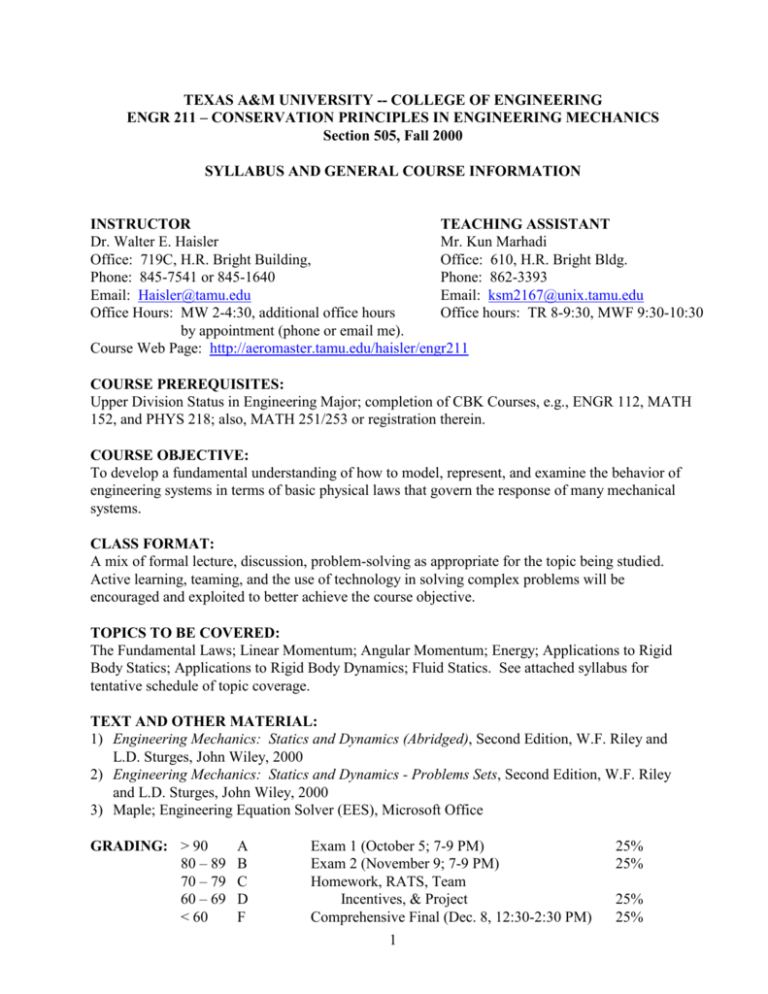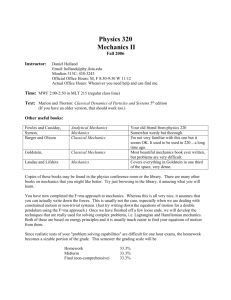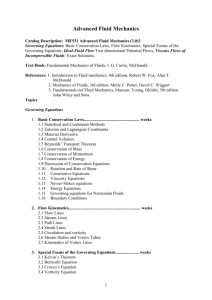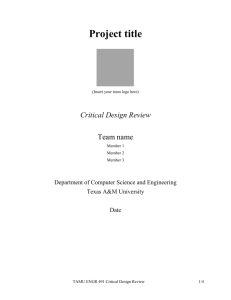Homework: - Aerospace Engineering Courses page
advertisement

TEXAS A&M UNIVERSITY -- COLLEGE OF ENGINEERING ENGR 211 – CONSERVATION PRINCIPLES IN ENGINEERING MECHANICS Section 505, Fall 2000 SYLLABUS AND GENERAL COURSE INFORMATION INSTRUCTOR TEACHING ASSISTANT Dr. Walter E. Haisler Mr. Kun Marhadi Office: 719C, H.R. Bright Building, Office: 610, H.R. Bright Bldg. Phone: 845-7541 or 845-1640 Phone: 862-3393 Email: Haisler@tamu.edu Email: ksm2167@unix.tamu.edu Office Hours: MW 2-4:30, additional office hours Office hours: TR 8-9:30, MWF 9:30-10:30 by appointment (phone or email me). Course Web Page: http://aeromaster.tamu.edu/haisler/engr211 COURSE PREREQUISITES: Upper Division Status in Engineering Major; completion of CBK Courses, e.g., ENGR 112, MATH 152, and PHYS 218; also, MATH 251/253 or registration therein. COURSE OBJECTIVE: To develop a fundamental understanding of how to model, represent, and examine the behavior of engineering systems in terms of basic physical laws that govern the response of many mechanical systems. CLASS FORMAT: A mix of formal lecture, discussion, problem-solving as appropriate for the topic being studied. Active learning, teaming, and the use of technology in solving complex problems will be encouraged and exploited to better achieve the course objective. TOPICS TO BE COVERED: The Fundamental Laws; Linear Momentum; Angular Momentum; Energy; Applications to Rigid Body Statics; Applications to Rigid Body Dynamics; Fluid Statics. See attached syllabus for tentative schedule of topic coverage. TEXT AND OTHER MATERIAL: 1) Engineering Mechanics: Statics and Dynamics (Abridged), Second Edition, W.F. Riley and L.D. Sturges, John Wiley, 2000 2) Engineering Mechanics: Statics and Dynamics - Problems Sets, Second Edition, W.F. Riley and L.D. Sturges, John Wiley, 2000 3) Maple; Engineering Equation Solver (EES), Microsoft Office GRADING: > 90 80 – 89 70 – 79 60 – 69 < 60 A B C D F Exam 1 (October 5; 7-9 PM) Exam 2 (November 9; 7-9 PM) Homework, RATS, Team Incentives, & Project Comprehensive Final (Dec. 8, 12:30-2:30 PM) 1 25% 25% 25% 25% GRADING PHILOSOPHY: Except for open-ended design problems, the problems in this class and the textbook usually have a unique answer (i.e., “the answer”). In grading problems, my philosophy is: 1) An engineer obtains a solution to a problem based on physical understanding of the problem and the solution is substantiated through supporting engineering analysis, 2) An engineer should always try to have a “gut-feeling” for the solution, i.e., he should know when the solution is obviously (or probably) wrong (because of math or other errors), 3) In most mechanics problems, the problem is dealing with forces, mass, temperature, area, etc. Thus, a solution is not 3.26 but 3.26 something (something = N, kg, ft2, psi, etc.). Units are essential!! You will be docked points for answers without units. 4) Incorrect solutions may receive partial credit if it is clear to me that your solution procedure is correct and you have satisfied 1-3 above. RE-GRADING POLICY: If you think you homework, RAT, or Exam was improperly graded, you have 1 week in which to submit your paper to me for re-grading after it has been returned to you. Submit your paper to me along with an explanation of what you consider to be relevant information that I should consider. No paper will be re-graded after this ONE-WEEK period. ATTENDANCE: Not much to be said here. I expect you to attend all classes and be on time. If you have an appropriate excuse to be absent, provide me with appropriate documentation (ahead of time, if appropriate). TEAMING: Group assignments will have the names of all team members on the finished product. ONLY members who have contributed equally to the assignment may sign the product. Only those members who sign will be given credit for the work. All members of the team are responsible for preventing anyone who did not work on the project from signing it. Remember the buck stops with you. I may, at my discretion, choose to quiz any member who signs the project to determine whether I believe they contributed. If I feel that the signing person did not contribute, the entire team will receive a zero on that work. If you choose to do so, you may assign people to become "experts" in certain areas, but if you do, each "expert" must assume the responsibility of teaching the other signing team members about their "field of expertise." In other words, the expert must teach the others in the group how to survive a grilling by the prof about how that part of the solution was obtained. If you divide the homework problems, you must meet together and teach each other how the problems are solved. Team Meeting Logs Each team should keep a weekly log of when it met, how long it met, and which team members were present. Weekly Meeting Log Sheets will be provided for your use at the first class meeting each week or may be downloaded from the course web site. The sheet for Week 1 is to be turned in at the first class meeting of Week 2; the one for Week 2 is due the first class meeting of Week 3; etc. For the purposes of these logs, a week is defined as Monday-Sunday. Team meeting log forms may be printed from the course web page. 2 Note 1: The instructor may, at his discretion, choose to quiz individuals about the details of whatever has been submitted. If it becomes obvious that the person being quizzed does not adequately understand what they have affixed their signature to, the grade for that item will automatically be recorded as a zero. This would apply to an individual grade in the case of an individual assignment, or to the team grade, in the event that the item in question is a team submission. Note 2: A peer evaluation opportunity will be provided 2-3 times during the course of the semester. As a part of this peer evaluation, each team member will be asked to evaluate the contribution of other team member toward team activities. This team evaluation will be applied as a multiplying factor of your team grades. HOMEWORK: There will be two homework assignments per week with a mix of individual and team assignments. 1) Homework will be due one week after the date of assignment and is to be turned in at the beginning of class before I start lecturing. Late homework will NOT be accepted. There will be NO exceptions. 2) Homework must be complete with all steps shown. You may use computer software (Maple, EES, etc.) and/or calculators to complete tedious calculations but you must describe what you did and show computer output if computer software was utilized. 3) Work on one side of the paper only. Staple your work together. Submit all problems and work in the order that they were assigned. 4) Your final answer must be easily identifiable (either boxed, highlighted, underlined, separate from other work, etc.) and must appear with appropriate units. 5) Your team number must appear on all work along with the name of each group member who worked on the project. No person who did not contribute to the project is permitted to affix their name to the project - this is considered scholastic dishonesty, and will be grounds for removal of the group from the class. PLEASE TAKE THIS SERIOUSLY, WE DO. READING ASSIGNMENTS: You are responsible for reading and studying the text material that has been assigned for a particular lecture. This is your responsibility whether I remind you or not. A detailed syllabus with reading assignments is attached. READINESS ASSESSMENT TESTS (RATS): You may want to call these pop quizzes. RATs will be 5-20 minute closed book exams. In order to be ready for a RAT, you must have read the assigned material, listened in class, and have done and understood the homework. RATS may be individual effort, or sometimes you will be required to work as a team. Note that it is your responsibility to make sure everyone in your team understands how to work the RATs. Sometimes, the instructor may give two RATs back-to-back. The first one could be solved as a team. The second one could be the same or very similar problem, to be worked individually. At the instructor's discretion, the team score for both RATs could be the lowest, highest, or average score of the team members on the individual RAT. 3 PROJECTS: A major teaming project will be assigned. Each team will be assigned a grade based on their solution to the problem, and will be required to submit a formal engineering report that includes the contribution of each team member. Your individual grade will be based on the team grade and your individual contribution. The grade will be based on both the technical engineering content of the report, and the formal written presentation. Each member of the team will be required to document which portion of the project and report they completed. The required format of the project report will be provided with the project assignment. MAJOR EXAMS: The Major Exams will be closed book. There will be NO make-up exams except with a universityapproved absence. See exam coverage and schedule on syllabus. Major Exams may be given as a team, individual or a combination effort thereof. For a team plus individual exam, each portion will be weighted appropriately (as an example; team portion of exam 20% and individual portion of exam 80%). FINAL EXAM: The final exam for this course will be given on Wednesday, December 8, 12:30-2:30 PM. It will be comprehensive in that you will be responsible for all material covered during the course. There may, however, be a greater emphasis on material covered during the latter half of the semester. EMAIL ADDRESSES AND LISTSERV SUBSCRIPTION: In order for me to easily communicate with you at times other than our class time, I need for each of you to have a valid TAMU email address. (hotmail, AOL, tca, etc. addresses will not work. This is done to prevent spamming by non-TAMU domain email addresses.) 1) If you don't have a TAMU email address, get one immediately (you are already paying for it!). 2) Sign up for the ENGR211 newsgroup by sending an email to listserv@listserv.tamu.edu and in the BODY of the email, put "SUBSCRIBE ENGR211 firstname lastname" WITHOUT the quotes. Replace firstname and lastname by your name. Be sure you send the email when logged on to YOUR TAMU account (not someone else's)!!! Note: it is listserv NOT listserve! 3) Check your email once a day or so. SOME THOUGHTS FROM THE INSTRUCTOR (on learning and life): I cannot teach you everything or show you the solution to every problem in the world; therefore, you must learn the basic principles and procedures and not solutions to specific problems. Taking responsibility for your own actions, words and station-in-life allows you (forces you) to grow as a person. 4 Revised 8/30/00 ENGR 211 - Conservation Principles in Engineering Mechanics Section 505, Fall 2000 Tentative Schedule 1 2 Class Meeting Aug. 29 Aug. 31 3 Sept. 5 4 5 6 7 8 9 Sept. 7 Sept. 12 Sept. 14 Sept. 19 Sept. 21 Sept. 26 10 11 Sept. 28 Oct. 3 12 Oct. 5 Oct. 5 13 Oct. 10 14 Oct. 12 15 Oct. 17 16 Oct. 19 17 Oct. 24 18 Oct. 26 19 Oct. 31 20 Nov. 2 21 Nov. 7 22 Nov. 9 Nov. 9 23 Nov. 14 24 Nov. 16 25 Nov. 21 Nov. 23 26 Nov. 28 27 Nov. 30 28 Dec. 5 Dec. 8, 12:30-2:30 PM Topics to be Covered Introduction to the Course Introduction to Mechanics, Newton's Four Laws, Units Accounting Concept, Conservation Tables, Conservation of Mass Conservation of Mass Examples Concurrent Force Systems Conservation of Linear Momentum Conservation of Angular Momentum Rigid Bodies, Equivalent Force Systems Centroids, Distributed Loads, Equivalent Force Systems COLM for Rigid Bodies Discussion of external support conditions, Introduction to trusses, method of joints Trusses, method of sections Reference Material WH: A1 RS: 1,12 WH: A2 WH: A2 RS: 2 WH: A3, RS: 3 WH RS: 4 RS: 5 RS: 6 RS: 6,7 RS: 7 Quiz A, Oct. 5, 7-9 PM Frames and Machines RS: 7 Internal Forces in Frames and Machines RS:8 Area and Mass Moments of Inertia RS: 10 Kinematics of Particles RS: 13 Kinematics of Rigid Bodies RS 14 Kinematics of Rigid Bodies RS 14 Kinematics of Rigid Bodies RS 14 Friction, Kinetics of Particles RS: 9, WH Kinetics of Rigid Bodies WH Kinetics of Rigid Bodies WH Quiz B, Nov. 9, 7-9 PM Conservation of Energy WH, RS: 11 Kinetics of Particles and Rigid Bodies - Energy WH Kinetics of Particles and Rigid Bodies - Energy WH No class - Thanksgiving Impulse and Momentum, Impact WH Variable Mass Flow WH Topics as needed Final Exam, Dec. 8, 12:30-2:30 PM WH=Haisler's class notes, RS=Riley & Sturges (number refers to chapter in text) 5 ENGR 211 – CONSERVATION PRINCIPLES IN ENGINEERING MECHANICS SECTION 505 -- FALL 2000 SOME USEFUL INFORMATION EES - How to get it and how to use it Get it from: http://www.mengr.tamu.edu/ees/ Hints on how to use it: http://Lowery.tamu.edu/ees/howtoees/ees.htm Teaming - What is teaming and how do you use teams effectively http://Lowery.tamu.edu/teaming/morgan1 Other useful websites (links are included at bottom of my ENGR 211 web page) http://www2.ncsu.edu/unity/lockers/users/f/felder/public/papers/student_handouts.html http://www.howstuffworks.com Some Do's and Don'ts I. USE OF VECTORS Almost all mechanics equations are vector equations. You must be able to do vector algebra and calculus to work mechanics problems. Vectors must be denoted clearly, e.g., with an overbar or an underbar. Vector equations written using scalar notation are wrong. Equations which equate vectors to scalars, use scalars where vectors are required (e.g., cross products), contain division by vectors, indicate vector multiplication without a dot or a cross product, etc., are wrong. II. CONSISTENCY (OR THE DEVELOPMENT OF GOOD AND BAD HABITS) There is an old saying that, "Practice makes perfect." This saying is incorrect; rather, "Practice makes consistent." Perfect practice makes you consistently perfect. Bad practice makes you consistently bad. Many people who don't use correct vector notation, etc., on homework say they will do it right on the exam. Wrong! If you practice it wrong, that is how you will do it on the exam; under pressure you will revert to the habits you have practiced, be they good or bad. The best way is to do it right all of the time. III. UNITS The US unit of mass is the slug, not the pound. If you are given a weight in pounds (lbf), divide by g = 32.174 ft/sec2 to get the mass in lbf-sec2/ft or slugs (m = W/g). Also remember that 1 slug is not equal to 1 lbm, when using that notation. To convert between mass and weight in SI units, use g = 9.807 m/sec2, not 32.2! The easiest way to think consistently is to remember that the US units specify a force or weight in lbf (thus making the mass have derived units of lbf-sec2/ft) while SI units specify mass in kg (thus making force or weight have derived units of kg-m/sec2 = Newtons). Always use units in evaluating an equation. If the units don’t match up in various terms of a long equation; this is telling you something: the equation is wrong, you have mixed units that need conversion, or something. For example, in dynamics problems, which can be worked by conservation of momentum and/or energy principles, if your work results in terms that look like linear momentum (kg m/s) and energy (N m) and you are trying to add them; then something is wrong! IV. SLOPPY MATHEMATICS The language of mathematics is very precise, and the mathematics used for mechanics is very well defined. You cannot ignore signs, equations, etc., because they don't agree with what you expect. For example, if you have two scalar equations involving only one unknown you cannot arbitrarily solve one equation for the unknown and ignore the other equation. Over determined systems are usually inconsistent; i.e., there is no value of the unknown that satisfies both equations. Inconsistent equations tell you that something is wrong (the assumptions, equations, or mathematics which preceded the equations). Only by pure luck will you 6 get the correct answer by solving one of the equations and ignoring the other. If the math gives you inconsistent equations, signs, etc., it is trying to tell you something; go back and find your error. 7 TEXAS A&M UNIVERSITY -- COLLEGE OF ENGINEERING ENGR 211 – CONSERVATION PRINCIPLES IN ENGINEERING MECHANICS SECTION 505 -- FALL 2000 SOME POTENTIALLY USEFUL INFORMATION FOR EXAMS STRATEGIES FOR TAKING AN EXAM; IN PARTICULAR, EXAMS IN ENGR 211 Quickly read all of the problems and note their point value before you start work on any problem. Answer the problems you judge to be easiest first and the hardest problems last. Do not spend more time on a problem than its point value justifies (unless you have already attempted all of the other problems). If you can do the easier problems quickly you may have extra time for the harder problems. Do not assume that the order in which the problems are presented is also the order of increasing difficulty. Make sure you pace yourself as you work through an exam. For example, let us say you have roughly 100 minutes to earn 100 points. The time that you can spend on a particular page of the exam is therefore about the same (in minutes) as the point value of that page. Do not get stuck on one page -- move on! You can always come back later if you have time left over. When you finish any engineering problem you should check your answers to see if they make sense and are dimensionally correct. If you come up with an answer that you know is wrong but you do not have time to find your error, write the grader a short note stating that the answer is wrong and why, and that you could not find and correct your error in the available time. For example, if you calculate that the tension in a cable is negative, then something is obviously wrong since you cannot push on a rope. Write "Negative tension impossible. Out of time." on your paper so that the grader at least knows that you realized your answer was physically impossible. Study early and get plenty of sleep the night before the exam. You may be able to cram the night before some exams and learn enough facts to do well; however, cramming does NOT work for engineering courses. In these courses, there are a minimum number of facts (principles) that you have to UNDERSTAND AND KNOW HOW TO APPLY to do well on an exam. To do well on a dynamics exam you must be able to THINK during the exam (apply basic principles to problems you have not seen before), NOT recite facts or PLUG NUMBERS INTO EQUATIONS. You will perform better if you learn the principles/facts early and get a good night's sleep the night before the exam. It is also not a good idea to try and digest a lot of information in the 3-4 hours just prior to an exam. A cursory glance at notes or at examples in the textbook often results in your spending precious time trying to recall what it was that you saw when you see a similar figure accompanying an exam problem. You would be much better off focussing on the problem you have actually been asked to do. 8 TEXAS A&M UNIVERSITY -- COLLEGE OF ENGINEERING ENGR 211 – CONSERVATION PRINCIPLES IN ENGINEERING MECHANICS SECTION 505 -- FALL 2000 TEAM MEETING LOG -- WEEK 1 (August 27, 2000 - September 2, 2000) TEAM Number: __________ This team met on ____________________ from __________ to __________ The following team members were present: ______________________________ ______________________________ ______________________________ ______________________________ This team met on ____________________ from __________ to __________ The following team members were present: ______________________________ ______________________________ ______________________________ ______________________________ This team met on ____________________ from __________ to __________ The following team members were present: ______________________________ ______________________________ ______________________________ ______________________________ This team met on ____________________ from __________ to __________ The following team members were present: ______________________________ ______________________________ ______________________________ ______________________________ 9 Team Information. I am requesting this information in order to form teams as best as possible. Think of me as the chief engineer whose job it is to form a team in such a way that the team has the best chance of success in solving difficult assignments. I will keep your information confidential. If you have problems with completing any item, skip it (only exception is prerequisites). Name: ____________________________ Email address: ____________________________ Major: ____________________________ GPA: _______________ Prerequisites: Do you have upper level standing in your Major? YES NO If you answered YES above, skip the following questions: Have you completed MATH 152 with a C or better grade and are currently registered for MATH 251 or 253? YES NO Have you completed PHYS 218 with a C or better grade? YES NO If your answer to either is NO, you do not have the pre-requisites for upper level standing and must drop this course. If you believe you should be in upper level, you must immediately see your advisor and bring me a letter from your advisor by 5 PM, August 31, stating why you should be enrolled in 211 or that you have been admitted to upper level. Otherwise, you will be dropped from 211. Sex: F M Ethnic Group: ________________ Live on campus? NO YES If YES, NORTHSIDE DORMS or SOUTHSIDE DORMS If NO, where? Put an X on the map below. Do you work? YES NO If YES, what hours? _______________________. Do you need to sit at the front of the classroom (poor vision, hearing, or just prefer)? 10 YES NO Have you worked on a team before? YES NO If yes, tell me your experiences. 11







